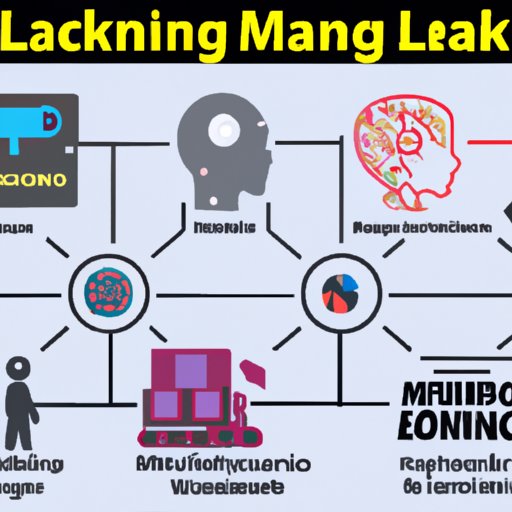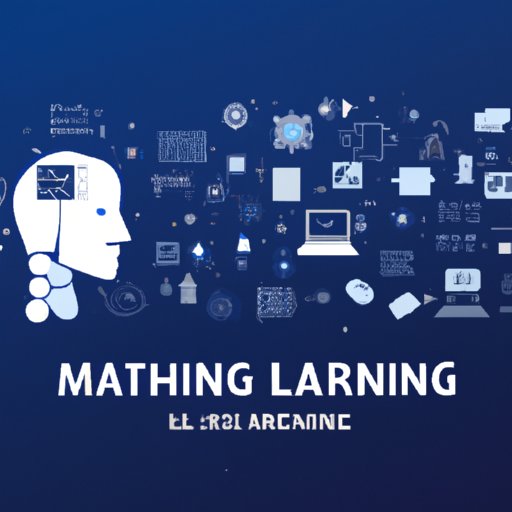Introduction
In recent years, advances in technology have allowed for the development of artificial intelligence (AI) and machine learning (ML). AI is a broad field that involves developing computer systems capable of completing tasks that typically require human intelligence, such as visual perception, speech recognition, decision-making, and language translation. ML is a type of AI that focuses on giving computers the ability to learn from data and make decisions without being explicitly programmed to do so.
The purpose of this article is to provide a comprehensive beginner’s guide to understanding machine learning and its role in AI. We will look at what machine learning is, how it works, and its various applications. We will also discuss the advantages and challenges associated with machine learning.
Introducing Machine Learning: A Beginner’s Guide to AI
Machine learning is a type of artificial intelligence that enables machines to learn from data and improve their performance over time. This is done by using algorithms that are designed to identify patterns in data and make predictions or decisions based on those patterns. Unlike traditional programming, which requires humans to write code to tell the computer what to do, machine learning algorithms can be trained to recognize patterns and make decisions without explicit instructions.
There are many benefits to using machine learning in AI. For example, it can reduce the need for manual programming, making it easier to develop complex AI systems. Additionally, machine learning algorithms can be used to automate tasks and make decisions more quickly and accurately than humans. Finally, it can help AI systems become more efficient and effective by continuously learning from data and improving their performance over time.

A Comprehensive Overview of Machine Learning and its Applications
There are several types of machine learning, each of which has its own set of applications. The most common types are supervised learning, unsupervised learning, and reinforcement learning. Supervised learning algorithms are trained using labeled data, while unsupervised learning algorithms use unlabeled data. Reinforcement learning algorithms are used to teach AI agents how to interact with their environment and maximize rewards.
Examples of machine learning applications include computer vision, natural language processing, autonomous driving, robotics, and predictive analytics. Computer vision uses algorithms to interpret images and videos, while natural language processing uses algorithms to interpret and generate text. Autonomous driving uses algorithms to enable vehicles to drive autonomously, while robotics uses algorithms to enable robots to complete tasks. Predictive analytics uses algorithms to predict outcomes based on historical data.
How Does Machine Learning Work in AI?
At a high level, machine learning consists of two main components: algorithms and data. Algorithms are mathematical models that are used to process data and make predictions or decisions. Data is the information that is used to train the algorithm. In order for a machine learning algorithm to work, it must be trained using labeled data.
Once the algorithm is trained, it goes through a process known as inference. During inference, the algorithm is presented with new data and makes predictions or decisions based on what it has learned. This process is repeated until the algorithm is able to make accurate predictions or decisions.
The process of training a machine learning algorithm typically consists of four steps: collecting data, preprocessing the data, building the model, and evaluating the model. Collecting data involves gathering the necessary information needed to train the algorithm. Preprocessing the data involves cleaning and formatting the data so that it can be used by the algorithm. Building the model involves constructing the algorithm and training it on the data. Finally, evaluating the model involves testing the accuracy of the algorithm and making adjustments as necessary.
The Basics of Machine Learning and its Role in AI
Machine learning is becoming increasingly important in the development of AI systems. It enables AI systems to learn from data and make decisions without explicit programming. Additionally, it allows AI systems to become more efficient and effective by continuously learning from data and improving their performance over time.
There are many advantages to using machine learning in AI, including reducing the need for manual programming, automating tasks, and making decisions more quickly and accurately than humans. However, there are also some challenges associated with machine learning, such as obtaining labeled data and dealing with bias in the data.
Conclusion
In conclusion, machine learning is a powerful tool for developing AI systems. It enables machines to learn from data and make decisions without explicit programming. Additionally, it can reduce the need for manual programming, automate tasks, and make decisions more quickly and accurately than humans. However, there are also some challenges associated with machine learning, such as obtaining labeled data and dealing with bias in the data.
Understanding the basics of machine learning is essential for anyone interested in developing AI systems. This article has provided a comprehensive introduction to machine learning and its role in AI, from the overview of machine learning to the components and steps of the machine learning process.
Summary of Key Points
• Machine learning is a type of AI that enables machines to learn from data and make decisions without explicit programming.
• There are several types of machine learning, each of which has its own set of applications.
• The process of training a machine learning algorithm typically consists of four steps: collecting data, preprocessing the data, building the model, and evaluating the model.
• There are many advantages to using machine learning in AI, including reducing the need for manual programming, automating tasks, and making decisions more quickly and accurately than humans.
• However, there are also some challenges associated with machine learning, such as obtaining labeled data and dealing with bias in the data.

Final Thoughts on Machine Learning
Machine learning is an important part of developing AI systems and is rapidly becoming a key component of many industries. Understanding the basics of machine learning is essential for anyone interested in developing AI systems. This article has provided a comprehensive introduction to machine learning and its role in AI, from the overview of machine learning to the components and steps of the machine learning process.
(Note: Is this article not meeting your expectations? Do you have knowledge or insights to share? Unlock new opportunities and expand your reach by joining our authors team. Click Registration to join us and share your expertise with our readers.)
